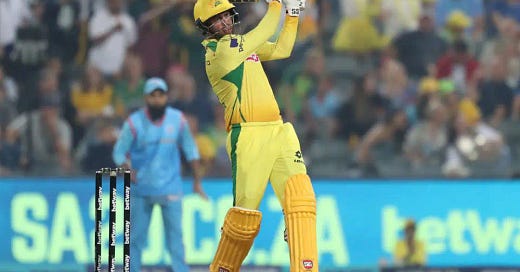Donovan Ferreira
It wasn’t the biggest six of the match. That one had come six balls earlier when Donovan Ferreira launched a Hardus Viljoen delivery into the stands overlooking the long-on boundary. That maximum had travelled 106 metres and succeeded Heinrich Klaasen’s blast which had measured 105 metres and landed on the roof of Kingsmead Stadium. Klaasen’s came in Durban Super Giants’ match against Sunrisers Eastern Cape, and he had held the record for the longest six for just a few hours.
This one, the one that came six deliveries after the longest six in SA20, was history-making, and again, it succeeded a benchmark set by Heinrich Klaasen. In January 2023, Klaasen recorded the fastest half-century in the SA20 with a 19-ball 50. 12 months and six days later, Ferreira set a new record with an 18-ball half-ton.
When he arrived at the crease, the Joburg Super Kings were trying to dig themselves out of a dire situation. They were on 94/4. This was a situation tailor-made for the 25-year-old batter. He has a knack for rescuing innings from the brink. He did it at Easterns, did it for the Titans, showed he could do it for the Proteas and did it for JSK in 2023. Ferreira arrived at the crease after another top-six collapse, JSK was marooned on 27/4. He blasted an unbeaten 82 off 40 that won the Johannesburg team the match.
“Batting in that in that five or six position, as a finisher, has a unique pressure because you are the last recognised batter and then you're going to allrounders or your bowlers. Sometimes you come in after a collapse and you have to rebuild or you come in at the end and have to clear the ropes from ball one. So, I think to succeed in that position you need to stay present,” says Ferreira.
According to Ferreira, the key to batting in that position is to resist scoreboard pressure. When the asking rate in a chase is 10 or 12 runs an over, most batters put themselves under pressure because to them it means that they have to score two or three boundaries every over, and when they get one or none, they translate it to say that they now need to hit five or six boundaries in the next over.
Ferreira plans his innings backwards. It’s a trick he learned from Jos Buttler during their time together with the Rajasthan Royals in the IPL. “I spoke to Jos Buttler about this as well, and he says, plan your innings backwards. So you say we need to get 50 runs off four overs, you're gonna get a big over somewhere. But, until you get to that big over, how are you going to get 10 runs with the other three overs or whatever the case might be, without taking unnecessary risks?” He says.
In his innings against DSG, JSK scored two fours in the first three overs Ferreira was at the crease. The asking rate was 10.8 and the Yellow Army had scored an average of 6.67 in those overs. But Ferreira was unbothered, he was sure he could catch up to the asking rate. And they did. Ferreira plundered 33 runs in the last nine deliveries he faced. 28 of those came off six boundaries, two sixes and four fours.
The finisher role is a precarious position to bat in, a largely thankless job, and Ferreira is always grateful when things work out because they don’t always do.
This newsletter is 100% reader-supported. If you’re willing and able, please consider supporting it in one of two ways, leaving a tip or becoming a Patreon. Thank you so much for your time and investment!
Simon Harmer
Quinton de Kock launched Daniel Worrall out of the stadium and onto the road. Heinrich Klaasen recreated a David Miller shot when he deposited a Liam Dawson delivery onto the Kingsmead roof. Now, only two batters have managed that feat. Wiaan Mulder blasted a quartet of consecutive sixes over deep midwicket, cover and a couple over long-on by Wiaan Mulder in the 19th over. The 24 runs off them lifted the Durban Super Giants from a possible 130-run total to a competitive 159.
Tristan Stubbs moered three sixes of his own in the chase, a slog sweep that cleared the fielder at forward square leg, a crowd silencing one over long-on to bring up his 50 and the last one sailed out of the ground and was picked up by a pedestrian who took a moment to pose for the cameras before handing the ball back.
But, it was Simon Harmer who owned the day. The offie upended history and wrote a chapter for himself in Kingsmead’s books. Kingsmead is not a particularly happy hunting ground for off-break spinners in T20 cricket. Offies average around 29 at an economy a shade under eight at the ground.
Leggies are the most successful. They go at 5.9 runs an over and take wickets every 16 balls. Orthodox spinners concede around 7.3 runs an over at an average of just under 25. The figures are mainly thanks to Keshav Maharaj, who has taken 14 wickets at an average of 20.4 for an economy of 7.03 and a strike rate of 17.4 in 13 T20s. The DSG captain is the leading wicket-taker at Kingsmead in T20s. Before the match against SEC, Maharaj was the only spinner in the list of top 10 wicket-takers at the ground.
Harmer invited himself to the party with his career-best bowling figures at Kingsmead. His 4/18 is now the best bowling figures by all bowlers at the ground. He bowled with so much control that 70.8% of his deliveries were dot balls. It's an insane percentage, one that Keshav Maharaj, the King of Kingsmead is yet to achieve. His highest dot ball percentage is 66.7 from their encounter against MI Cape Town in 2023.
If you found this interesting, please share it:
You can support Stumped! by leaving a tip:
Thanks for reading. Until next time… - CS






